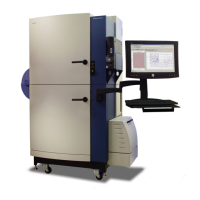FLIPR
®
Tetra High Throughput Cellular Screening System User Guide
0112-0109 H 165
Choosing Analysis Options
In the Analysis process, click on the Grouping, Correction or Export
buttons to define the analysis parameters to be applied to the
experimental data. For more information about these options see
Analysis Process on page 79.
When Finished Creating the Protocol
When you have finished defining the experiment parameters of the
processes in the Experiment window, click Save As and save the file as
an *.fmp file.
Optimizing the Optics and Fluid Dispensing
Optimizing the Hardware Settings
Prior to screening, the following hardware components should be
optimized for signal output and detection:
• Excitation intensity
• Exposure time
• Number of reads
• Camera gain for EMCCD camera
• Gate Open for ICCD camera
• Pipettor height
• Dispense speed
• Dispense volume
• Cell parameters for suspension assays.
Optimizing Optics Hardware
Optimization is available to help amplify weak signals or reduce
saturation. Modifying read settings may not alter the quality of your
data because it only regulates the amount of light emitted or detected
by the system. For instance, doubling the excitation intensity will
double the RLUs detected by the system, but your signal-to-noise ratio
and Z'-factor may remain the same.
To optimize the fluorescence signal:
1. Place the cell plates on the read positions.
2. Start with the excitation intensity, camera gain and exposure
time settings shown below. These settings are the most
frequently used to measure basal fluorescence signal.

